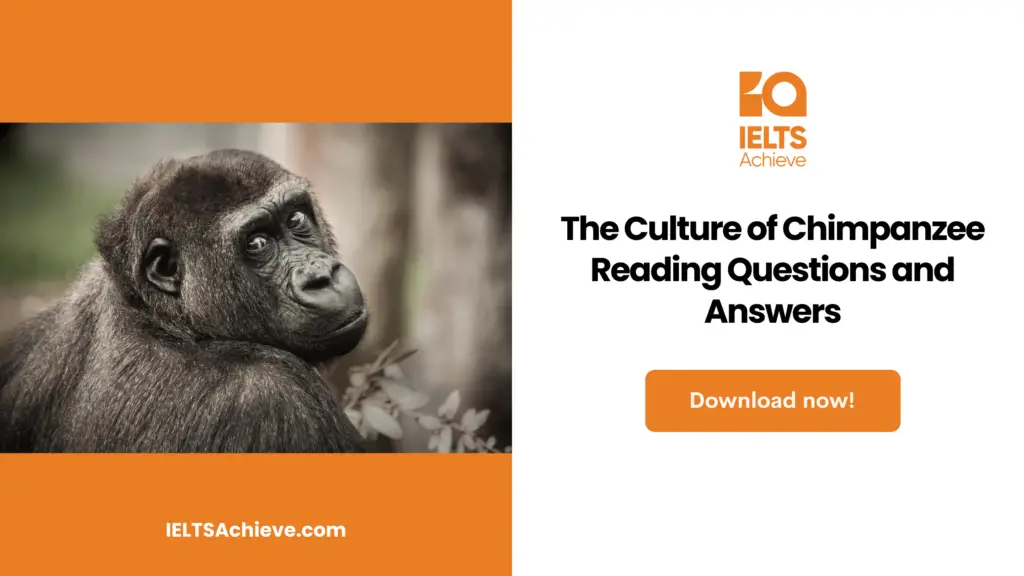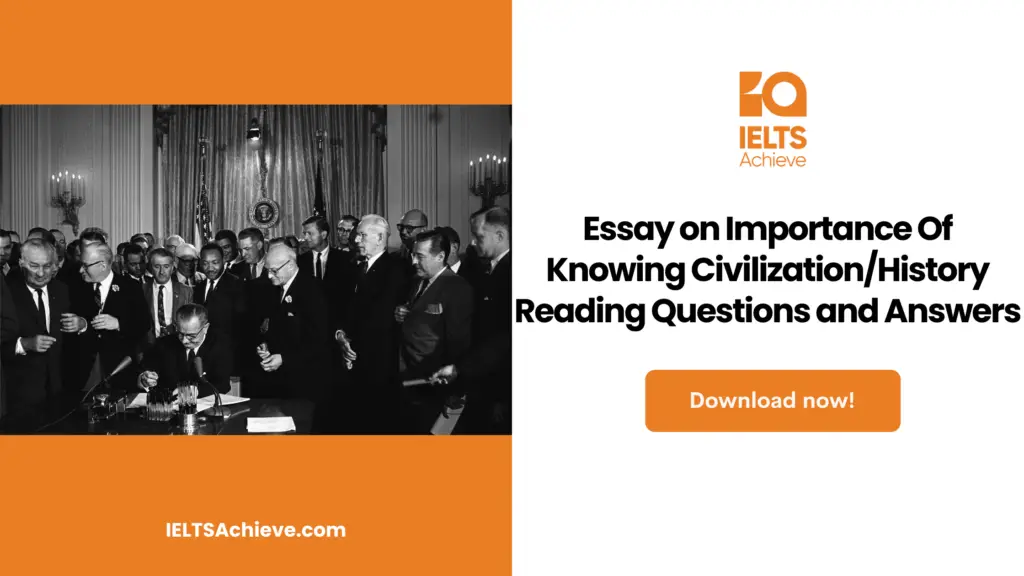The Blog post contains the following IELTS Reading Questions:
- IELTS Reading Locating Information
- IELTS Reading True/False/Not Given
- IELTS Reading Short Answer Questions
Stay informed and prepared for success – Explore our comprehensive Reading Test Info page to get valuable insights, exam format details, and expert tips for mastering the IELTS Reading section.
IELTS reading passage – The Culture of Chimpanzee

The Culture of Chimpanzees
A. The affinities between chimpanzees and humans were scrutinised for years, but in the last ten years, scientists have found that these similarities are far more extensive than originally believed. For example, the Taï Forest’s witnessed nut-cracking is not an usual chimpanzee action; instead, it is a unique adaptation that can only be found there and is characterised by scientists as a sign of chimpanzee culture. The term “culture” is often used by researchers to describe simple animal behaviours, like the local accents of diverse songbird species. But it turns out that chimpanzees’ rich and diverse cultural traditions are only second to human traditions in terms of complexity.
B. In the last two years, a unique scientific partnership including most of the main chimpanzee research teams has identified a wide range of unique cultural patterns spanning throughout Africa, in behaviours ranging from the use of equipment to social norms and communication methods. This new understanding of chimpanzees alters our perceptions of these magnificent creatures, as well as how we perceive our own peculiarities and the ancestral roots of our incredible ability for civilization.
C. Although Pan troglodytes and Homo sapiens have lived side by side for millennia and share over 98 percent of their genetic profile, humans grasped very little about chimpanzee behaviour in the open only four decades ago. After Jane Goodall and Toshisada Nishida of Kyoto University in Japan began researching wild chimpanzees at two study locations in Tanzania in the 1960s, things transitioned. (Goodall’s study station at Gombe, the first of its type, is better known, but Nishida’s station at Mahale is the second-oldest chimpanzee research site in the world.)
D. Incredible observations began to emerge in these early research as the chimpanzees grew accustomed to being close observation. Experts observed a huge variety of unanticipated behaviours, including manufacturing and using tools, hunting, eating meat, sharing a meal, and fighting deadly scuffles with neighbours. Other primatologists set up camp elsewhere in the following years, and despite all the logistical, monetary, and political challenges that may befall African research, a few of these outposts developed into genuine long-term endeavours. As a consequence, we are living in a unique period in human history when a thorough and detailed scientific record of the lives of chimpanzees is now available—and not just for one community in Africa, but for numerous.
E. Gombe chimpanzees seemed to employ 13 different types of tools, compared to chimpanzee groups elsewhere, and engaged in eight different social activities, according to Goodall’s 1973 observations. She speculated that some variants might have what she labelled a cultural origin. However, what did Goodall precisely mean by “culture”? Culture is described as “the habits… and accomplishments of a specific period or individuals” in the Oxford Encyclopedic English Dictionary. Human civilizations are varied in each and every aspect, from technological advancements to wedding ceremonies, from eating habits to mythology and folklore. Obviously, myths and stories do not exist for animals. However, they are able to pass on behavioural features from one generation to the next by learning rather than using their DNA. This is the primary need for a cultural feature as per biologists: it must be an ability that can be acquired from watching the developed capacities of others and then transmitted on to successive generations.
F. What about the effects on chimpanzees themselves? We must draw more attention to the catastrophic decline of chimpanzee populations, whose numbers are falling just as we are beginning to fully understand these wonderful animals. Due to illicit logging, trapping, and even more recently, bushmeat trafficking, populations have been reducing over the last century and are still dropping. The latter is especially concerning as routes have been built into the woods as a consequence of deforestation, and these are being utilised to transport wild animal meat, including chimpanzee meat, to people as far away as Europe. Together with the animals themselves, various intriguingly varied ape cultures are also under threat from this catastrophe.
G. However, the ape’s unique culture might still play a role in its redemption. Some locals’ attitudes have indeed shifted as a result of conservation activities. A few institutions have started to display videos that illustrate how intelligent chimpanzees are. One Zairian watcher was overheard saying, “Ah, this monkey is so like me, I can no longer eat him.”
H. How the most detailed study of the animals ever undertaken was carried out by an international team of chimpanzee specialists. For many decades, researchers have been studying chimpanzee culture, but all too often their discoveries missed a critical part. The majority of attempts to portray the cultural variety of chimpanzees have only depended on observations of the behaviour seen at each study location that have been formally published. However, for three reasons, this method likely ignores a considerable amount of cultural variance.
I. First off, it’s relatively rare for scientists to submit a detailed list of every activity they do not see at a specific site. The behaviours that were and were not seen at each location, however, are essentially what we really need to learn. Further, many narratives of chimpanzee conduct don’t indicate how frequent they are; without this data, we can’t tell whether a specific behaviour was an aberration or a regular occurrence that belongs in the species’ culture. Last but not least, it may be challenging for scientists working at different locations to record the existence or absence of the actions since the descriptions of the probable vital chimpanzee behaviours by researchers are typically inadequate.
J. The two of us decided to try a fresh plan to solve these issues. At each location, we requested a list from the field researchers of all the actions they believed to indicate local customs. With this data at our disposal, we compiled a thorough list of 65 potential cultural behaviours.
K. The team leaders at each location received our list after it was sent to them. They classified each behaviour in accordance with its presence or absence in the chimpanzee population that is being studied after consulting with their peers. The main categories included current (seen on the site but just not habitual), absent (never seen), customary behaviour and attitude (takes place in the majority or all of the able-bodied participants of at least one age or sex class, like all adult males), habitual actions (less prevalent than customary but happening repeatedly in several individuals), and unfamiliar behaviour.
Unlock your full potential in the IELTS Reading section – Visit our IELTS Reading Practice Question Answer page now!
Recommended Questions:
Renewable Energy IELTS Reading Question with Answer
The Culture of chimpanzee IELTS Reading Questions
Questions 1-5
Reading Passage has eleven paragraphs A-K. Which paragraph contains the following information? Write the correct letter A-K in the boxes 1-5 in your answer sheet.
1. Reasons why previous research on ape culture is problematic.
2. Based on the official sources, a drawback in research studies about chimpanzee culture.
3. An illustration depicting the gruesome result of animals leading to an alteration in the local residents’ attitude in preservation.
4. Reference of two scientists forming a new approach with the objective of solving the problem
5. Mention of new classification of data being observed or collected.
Questions 6-10
Do the following statements agree with the information given in the Reading Passage? In the boxes 6-10 of your answer sheet, write
TRUE if the statement is true
FALSE if the statement is false
NOT GIVEN if the information is not given the passage.
6. Mankind and apes have coexisted since a long time and share the majority of their genetic codes.
7. Research stated that scientists could inculcate complex cultures like those of human beings in chimpanzees.
8. Several astonishing cultured actions were observed amongst the chimpanzees, in the initial research of Toshisada and Goodall.
9. Similar to humans, the chimpanzees are capable of delivering a civilised behaviour due to genetic inheritance.
10. Researchers have studied the behaviours of chimpanzees by the information collected from both observed and undetected actions.
Enhance your skills in identifying information as True, False, or Not Given. Click here to discover expert strategies and techniques for mastering this question type in the IELTS Reading section.
Questions 11-14
Answer the questions below Using NO MORE THAN THREE WORDS for each answer. Write your answers in boxes 11-14 on your answer sheet.
11. Toshisada Nishida and Jane Goodall’s research field is located in which country?
12. What word accurately describes Jane Goodall’s 1973 discovery that chimpanzees in different areas utilised various tools?
13. When did the startling revelations regarding chimpanzee behaviour begin?
14. What did the chimpanzee in the first research become accustomed to?
Unlock your full potential in the IELTS Reading section – Visit our IELTS Reading Practice Question Answer page now!
Recommended Questions:
Renewable Energy IELTS Reading Question with Answer
The Culture of chimpanzees IELTS reading answers
1. I
2. H
3. G
4. J
5. K
6. TRUE
7. NOT GIVEN
8. TRUE
9. FALSE
10. FALSE
11. Tanzania
12. cultural origin
13. the 1960s
14. close observation

We hope you found this post useful in helping you to study for the IELTS Test. If you have any questions please let us know in the comments below or on the Facebook page.
The best way to keep up to date with posts like this is to like us on Facebook, then follow us on Instagram and Pinterest. If you need help preparing for the IELTS Test, join the IELTS Achieve Academy and see how we can assist you to achieve your desired band score. We offer an essay correction service, mock exams and online courses.


